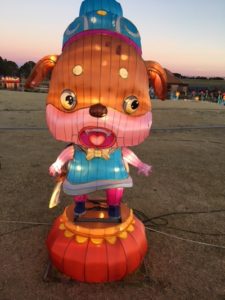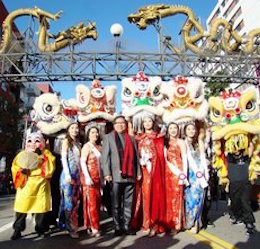How to Celebrate the Chinese New Year (of the Dog)
 (Gerry Furth-Sides, photos by Roberta Deen). Chinese cuisine and culture have influenced our way of eating for centuries in healthy, delicious ways. The wise Chinese always seem to have known psychologically what science now proves: the stronger the intentions for positive ideas we put into our consciousness, the stronger a chance of them coming true. Even the mainstream watered down versions of Chinese cuisines, such as the Chow Mein created by restaurant chefs for Americans unfamiliar with Asian flavors prove their business acumen and ingenuity to attract money.
(Gerry Furth-Sides, photos by Roberta Deen). Chinese cuisine and culture have influenced our way of eating for centuries in healthy, delicious ways. The wise Chinese always seem to have known psychologically what science now proves: the stronger the intentions for positive ideas we put into our consciousness, the stronger a chance of them coming true. Even the mainstream watered down versions of Chinese cuisines, such as the Chow Mein created by restaurant chefs for Americans unfamiliar with Asian flavors prove their business acumen and ingenuity to attract money.
Why not also look into the authentic lively and colorful traditions and customs of New Year, the most significant holiday on the Chinese calendar to welcome in the Year of the Dog? //www.thechinesezodiac.org/horoscope-2018
Spring Festival in China represents every good wish for the coming year, and a holiday reuniting families. Roads, airports, and train stations are packed with a mass migration prior to New year as thousands and thousands Chinese think nothing of traveling thousands and thousands of miles – including standing on a packed train for 20 hours or more – to reunite with friends and family.
Meanwhile, families at home thoroughly scrub their homes, sweeping away the bad luck of the past year. Dusting is also avoided on New Year’s Day, for fear that good fortune will be swept away.
Retail business soars with holiday sales. The closer to New Year’s Day, the deeper the discounts.
On New Year’s Eve, families gather for a sumptuous reunion dinner with the color red in as much of the home decor as possible. The choice of dishes and how they are eaten incorporations centers of customs and rituals to ensure abundance, good health, and happiness for the coming year.
Mandarin oranges are seen everywhere. They are considered such a strong symbol of good fortune, they are not only eaten but displayed and given as gifts. In northern China, dumplings are a popular food during Chinese New Year. In the south, niangao, a chewy pellet made from glutinous rice.
Dishes are carefully chosen to bring good luck to families. The beloved reunion New Year’s Eve dinner, comparable to the important western Christmas Day dinner, is multi-generational and a highlight of the year.
Traditional dishes vary from home to home and province to province, but the ideas behind each item and what they represent remain the same. Mandarin oranges are a mainstay thought out the country.
Mandarin oranges, which are considered such a symbol of good fortune, they are not only commonly eaten but displayed and given as valued gifts. The oranges were a key element in the play, “King of the Yees.”
The tradition of eating Fish (与) during the New Year stems from the fact that the Chinese word for “surplus” or “profit” sounds similar to the word for fish so that eating fish will bring wealth in the new year. A little bit of the dish should be left to represent the coming surplus.
Traditional Chinese Dumplings (Jiaozi – 饺子) are most popular in the northern provinces of the country. A thin skin of dough covers finely chopped meat and vegetables so that they resemble silver ingots to represent money. The idea is that the more you eat, the more money you will (hopefully!) get.
Niangao (年糕) is made of sticky rice, dates, sugar, and lotus leaves to represent the idea of increased fortune year after year.
Tangyuan (汤圆): sweet, small balls similar to dumplings made out of glutinous rice flour that is cooked and served in soup. The round shape of these balls represents the unity and reunion of a family and the act of coming together as one unit.
Vibrant scarlet decor adorns every street, storefront, and home. The color red is everywhere because it is associated with wealth and good fortune in Chinese culture. Red lanterns are hung on the streets and windows and doors decorated with posters and papers bearing auspicious characters or phrases.
The now famous red envelopes hold large and small cash gifts given by senior family members to junior relations, adults to children, married couples to younger, unmarried family members, and bosses to employees. Red is also visible in the bustling markets selling decorations, toys, clothes, and trinkets.
In Hong Kong and Macau, it is a tradition to give flowers and potted plants. Chinese potted kumquats and golden orange trees are also popular.
Spectacular New Year’s firecrackers are a reminder that the Chinese invented gunpowder. Red is also very visible because the rolled red paper in the firecrackers leaves shreds of scarlet paper. The belief is that the loud noise of the firecrackers scares away evil spirits.
Praying at the Temple The Lunar New Year season on the third day of the New Year means lighting incense and praying to the deities for blessings and good luck in the year ahead. Many major temples will stage festive dragon and lion dances in the courtyard.
Colorful traditional Lion and Dragon dances are performed outdoors because they resound with drums and symbols, thought to bring good luck. Often in the form of a street parade, a troupe of skilled acrobatic dancers performs the dragon dances while two dancers perform the lion dances.
 The 119th Annual Golden Dragon Parade and Chinese New Year Festival
The 119th Annual Golden Dragon Parade and Chinese New Year Festival
Feb. 17 celebrates the Lunar New Year in Chinatown with this parade, the oldest celebration of its kind in America, features floats and multiple marching bands (loud noise to scare away the demons), a culinary stage, cultural performances, family-friendly workshops, food trucks, face painting, magic and more. Parade 1-3 p.m., festival noon-8 p.m. Free, parade grandstand tickets $10-$20. lagoldendragonparade.com
China Lights in Las Vegas (also in Arkansas) is an event open from January 29 to February 25 at 628 W. Craig, North Las Vegas at the Craig Ranch Park (about 30 minutes from the Strip) with special activities on fireworks on February 16. “The lanterns can hold their own against the Downtown and Strip neons and glitz.” //localfoodeater.com/new-china-lights-lite-historic-la-asian-new-year-festivals/



 Gerry Furth-Sides
Gerry Furth-Sides  Barbara Hansen
Barbara Hansen  Chef-owner Alain Cohen
Chef-owner Alain Cohen  Roberta Deen
Roberta Deen  Jose Martinez
Jose Martinez  Nivedita Basu
Nivedita Basu